QUESTIONS
SECTION A (44 marks)
Answer all questions in this section in the spaces provided
- Outline three roles of the 1st officer or co-pilot.(3 marks)
-
- Give the reasons why the following safety equipment must be carried on an aircraft.
- Raft
- Axe(2 marks)
- Outline two safety precautions to observe when using each of the following tools:
- Hand files
- Taps(2 marks)
- Give the reasons why the following safety equipment must be carried on an aircraft.
-
- List the type of clouds which
- can project up into the stratosphere
- would cause moderate to severe aircraft icing(1 mark)
- Distinguish between the compass swing and the engine test areas.(2 marks)
- List the type of clouds which
-
- Sketch the following types of locking devices.
- Spring washer
- Shake proof washer(2 marks)
- State four properties of aluminium alloy which makes it suitable for aircraft construction.
- Sketch the following types of locking devices.
-
- Explain the meaning of each of the following terms as applied in aviation:(2 marks)
- Indicated airspeed
- Mach number
- Viscosity(3 marks)
- With the aid of sketches, describe each of the following wing configurations:
- Mid-wing
- Dihedral(4 marks)
- Explain the meaning of each of the following terms as applied in aviation:(2 marks)
-
- Outline three functions of the aircraft bulkhead.(3 marks)
- State the use of an inspection mirror in aircraft non-destructive testing (1 mark)
-
- Draw a cross-section of a cylinder piston assembly and show the following:
- Cylinder
- Piston
- Connecting rod
- Stroke(4 marks)
- Explain the application of Newton's third law of motion to a gas turbine engine.(2 marks)
- Draw a cross-section of a cylinder piston assembly and show the following:
-
- Outline three methods of flight control systems.(3 marks)
- Name the type of instrument used to indicate each of the following:
- Aircraft pitching up and down (1 mark)
- The rate of altitude change (6 marks)
- Outline the procedure of cutting internal threads.
- Draw the symbol for each of the following as used in technical drawing.
- First angle projection (1 mark)
- Switch socket outlet (1 mark)
- External threads (1 mark)
SECTION B (56 marks)
Answer any four questions from this section in the spaces provided.
-
- With the aid of a labelled sketch, show each of the following:
- Angle of attack
- Anhedral
- Angle of incidence(6 marks)
- State four factors that determine aircraft drag.(2 marks)
- With the aid of a labelled sketch, explain how the moments are balanced in flight.(6 marks)
- With the aid of a labelled sketch, show each of the following:
- With the aid of a labelled sketch, show the construction and airflow on a high bypass gas turbine engine.(14 marks)
- Describe each of the following areas of the airport:
-
- Threshold
- Runway
- Touch down zone (3 marks)
-
- Outline five major causes of accidents in the aviation environment.
- Name four ways of communicating on the airside.(7 marks)
- Explain the following aircraft tasks:
- Parking
- Picketing
- Jacking
- Trestling (2 marks)
- Draw and label a cross section of unbalanced double acting actuator.(2 marks)
- With the aid of a labelled cross-sectional sketch, describe an airspeed indicator.(10 marks)
-
- Figure 1 shows an aircraft engine bracket drawn in isometric projection. In good proportion, draw in first angle projection the following views:
- Font elevation in the direction of arrow F.E.
- End elevation in the direction of arrow E.E.
- Plan

MARKING SCHEME
-
- To assist in the safe and efficient conduct of the flight.
- Take charge of the aircraft if the captain is unable.
- Assist in the safe navigation of the flight.
-
-
- To help passengers and crew to float in case of a crash on water.
- To assist in breaking out of the aircraft in case of a crash for quick evacuation.
-
-
- Choose the right file for the material to be cut.
- Ensure the handle is fixed firmly.
- Keep the file clean by use of a file card or wire brush.
-
- Use the taps in their order, tapes, intermediate, plug or bottoming,
- The tap must be positioned vertically to the work piece.
- Avoid use of excessive force.
- Use cutting fluid.
-
-
-
-
- Cumulonimbus
- Nimbo Stratus
-
- This is a designated area where aircraft compass is tested.
- It is an area used to test run engine.
-
-
-
-

Spring washer -

Shake proof washer
-
-
- Corrosion resistant
- Malleable and ductile
- Good conductor of electricity
- Strong and light
-
-
-
- Indicated Speed: Airspeed of the aircraft indicated on the airspeed indicator.
- Mach Number: Speed of the aircraft in relation to the speed of sound.
- Viscosity: The resistance to flow in fluids.
-

MID WING
Straight wing fitted in the middle of fuselage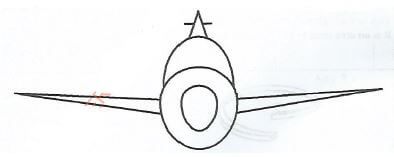
DIHEDRAL WING
Wing fitted to the fuselage inclined at an upward angle
-
-
-
- Partition the fuselage
- Contain pressure (Pressure bulkheads)
- Fire wall (fire bulkhead) separate heat areas.
- Used to aid visual inspections particularly in hidden areas.
-
-
-
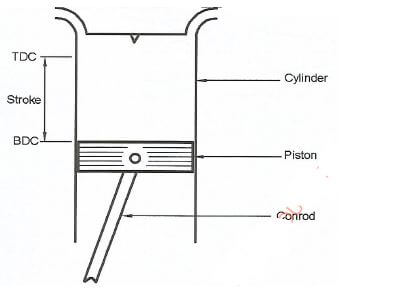
Sketch - 1 mark
Correct labelling by 6 x 1/2 = 3 marks -
- There must be an equal but opposite reaction.
- The mass of air is given an acceleration through the exhaust and this reaction pushes the aircraft in the opposite direction. (Thrust)
-
-
-
- Manual - mechanical operated
- Powered - hydraulic operated
- Fly by wire - Electrically operated
-
- Altitude indicator
- Vertical Speed Indicator (VST)
-
- Tapping procedure
- Drill hole to correct size.
- Enter tap perpendicular to the work piece and turn in cutting direction
- Test the tap for squareness.
- Continue turning in cutting direction for half a turn then reverse for quarter a turn.
- Change the second tap then plug tap (bottoming)
- Lubricate the work as you continue to cut.
-
-

first angle projection -

Switch socket outlet -

External screw threads
-
-
-

-
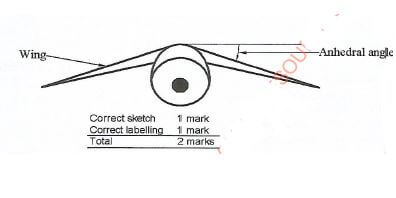
-
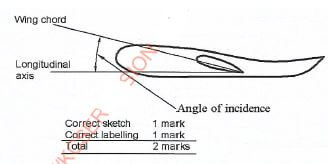
- Cd - co-efficient of drag
e - density of air
v2 - velocity squared
S.A - surface area -
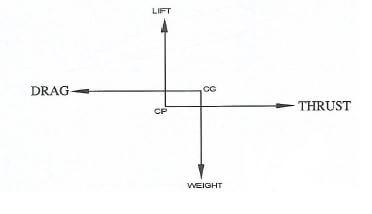
Explanation:
- thrust is parallel to drag
- lift is parallel to weight
- lift in front of the centre of gravity
- weight is behind the centre of pressure
-
-
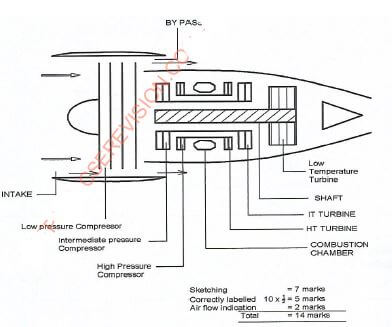
-
-
- THRESHOLD
It is the beginning of that portion of the run way usable for landing.
(marking the start of Runway for landing) - RUNWAY
A defined rectangular area on an airport prepared for the landing and take off of aircrafts. - TOUCH DOWN ZONE
The portion of the runway beyond the threshold intended for landing.
(Aeroplanes first contact on the runway)
- THRESHOLD
-
-
- Complacency (over sure)
- Hurriedness (Hasty reaction Poor communication
- Ignorance (lack of training)
- Failure to observe safety regulations
- Indiscipline and attitude.
- Poor judgement
- Weather conditions
- System malfunction
-
- Use of hand signals (marshalling)
- Use of flares or lights
- By radio
- Use of painted signs
-
-
- Putting an aircraft in designed safe area for static operations or storage.
- Securing the aircraft if it is to stay parked for long periods.
- Lifting the aircraft off ground for maintenance.
- Supporting the aircraft on trestles after it has been jacked to ensure safety during maintenance or if the aircraft has to stay on jacks for a long period.
-
-
-
- Lighter in weight
- Quick in response (dead beat)
- It is reliable
- Can be easily maintained
- It's not a shock or fire hazard.
-

sketch - 1 mark
label 2 x 1/2 - 1 mark
total - 2 marks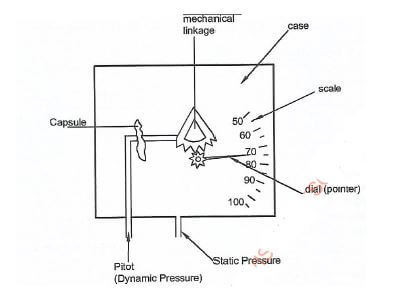
A sealed case ported to static pressure
A capsule (pressure sensitive) open to pitot pressure
Capsule movement amplified by mechanical linkage which moves a pointer over a scale,
Correct labelling (7 x 1/2)=31/2 marks)
Correct sketching (5 x 1/2) = 21/2 marks)
Description = 4 marks
-
-
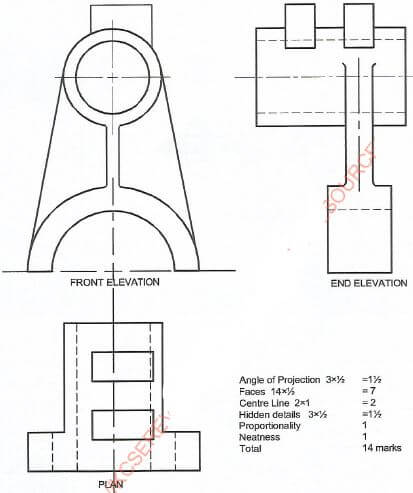
Download KCSE 2018 Aviation Technology Paper 1 with Marking Scheme.
Tap Here to Download for 50/-
Get on WhatsApp for 50/-
Why download?
- ✔ To read offline at any time.
- ✔ To Print at your convenience
- ✔ Share Easily with Friends / Students

